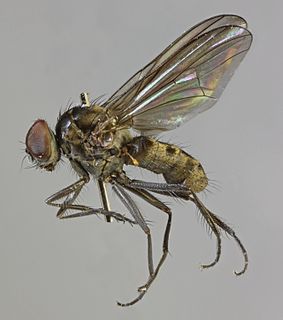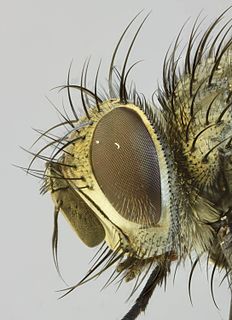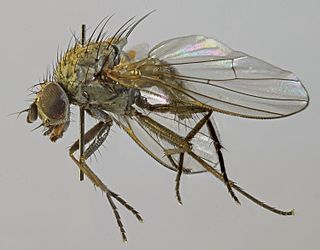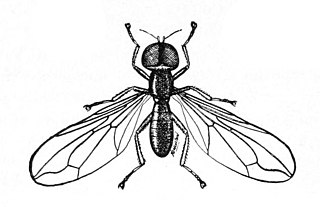
Pipunculidae is a family of flies (Diptera) commonly termed big-headed flies, a reference to the large (holoptic) eyes, which cover nearly the entire head. The family is found worldwide and more than 1300 species have been described.

Xylota sylvarum is a common Palearctic species of hoverfly.

Criorhina is a genus of hoverflies.Medium to large sized species, black or greenish black, with or without light ground markings mimicking bumblebees .The head is much flattened and broader than the thorax. The antennae are situated upon a prominent conical frontal process, The face is moderately produced below the eyes, downward or forward, in profile. The eyes are bare. The abdomen is elliptical or very short oval. .Larvae found in rot holes or decaying hardwoods

The Milesiini is a large and diverse tribe of hoverflies. They mimic wasps or hornets.

Milesia is a genus of very large hoverflies, which mimic social wasps. For example, the European species Milesia crabroniformis is a convincing mimic of the hornet species Vespa crabro. Milesia are predominantly Palaeotropical in distribution almost entirely Oriental.

Azelia nebulosa is a species of fly in the family Muscidae. It is found in the Palearctic.
Cephalops aeneus is a species of fly in the family Pipunculidae. It is found in the Palearctic.
Cephalops obtusinervis is a species of fly in the family Pipunculidae. It is found in the Palearctic.

Cephalops spurius is a species of fly in the family Pipunculidae. It is found in the Palearctic.
Dorylomorpha xanthopus is a species of fly in the family Pipunculidae. It is found in the Palearctic.
Tomosvaryella littoralis is a species of fly in the family Pipunculidae. It is found in the Palearctic.

Verrallia aucta is a species of fly in the family Pipunculidae. It is found in the Palearctic.

Medina collaris is a species of fly in the family Tachinidae.

Phryxe nemea is a species of fly in the family Tachinidae.

Azelia cilipes is a species of fly in the family Muscidae. It is found in the Palearctic.

Paykullia maculata is a species of fly in the family Rhinophoridae first described by Carl Fredrik Fallén in 1815.

Pipunculinae is a subfamily of big-headed flies.

Pipunculus is a genus of flies belonging to the family Pipunculidae. The genus has a cosmopolitan distribution.
Cephalops carinatus is a species of fly in the family Pipunculidae.











